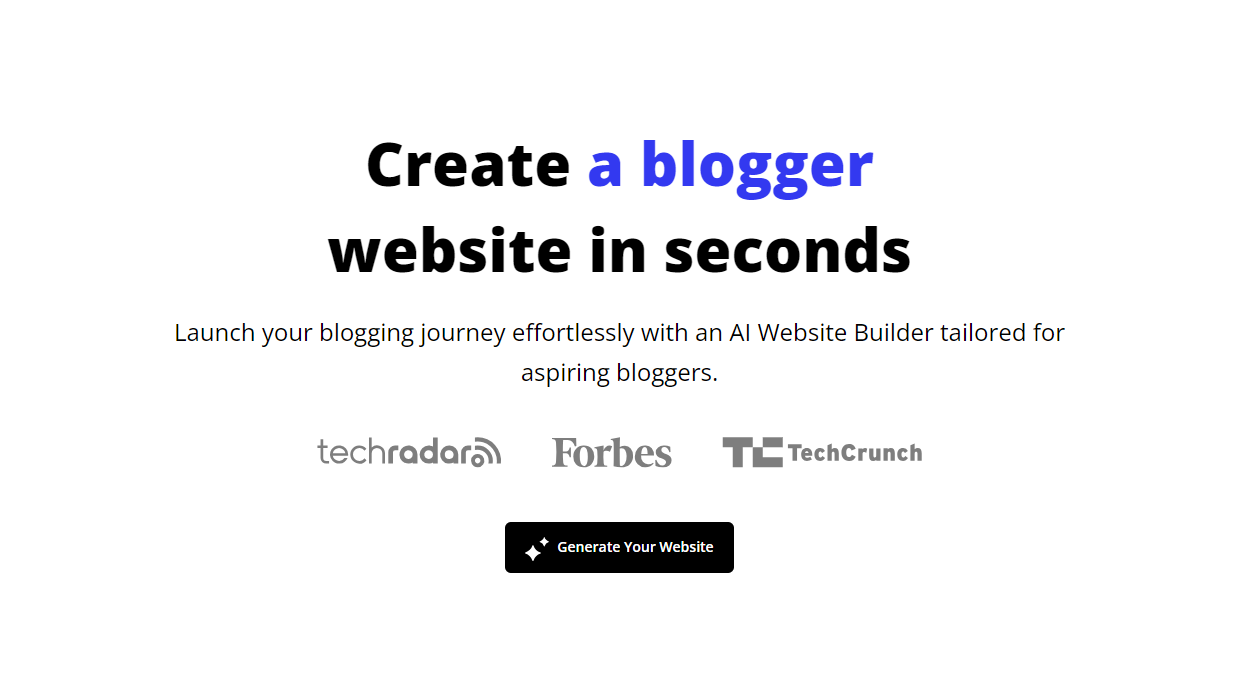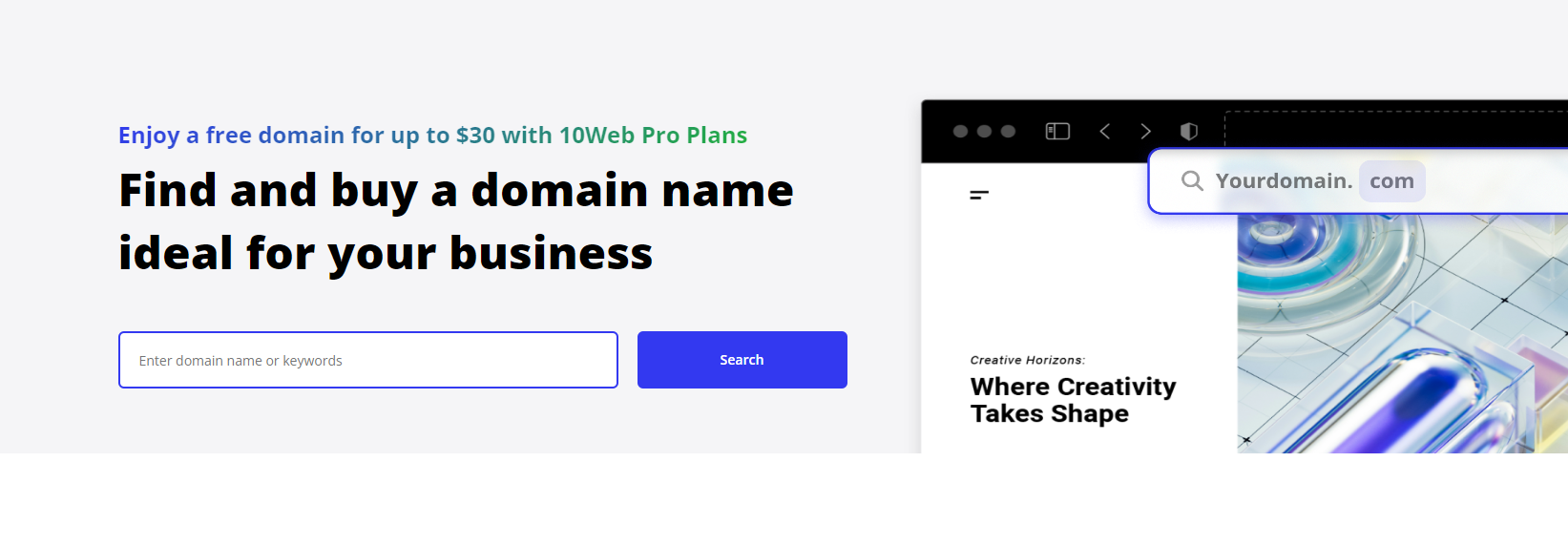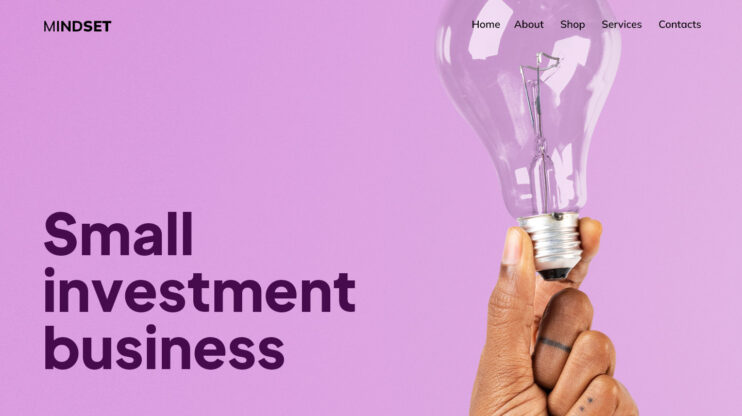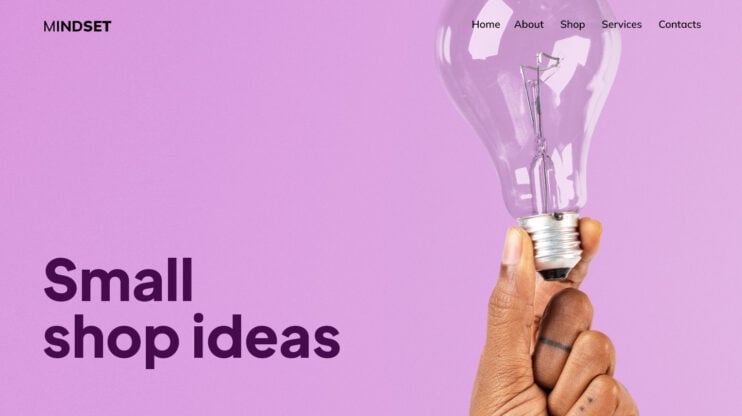Blogging has become one of the most accessible ways to share your ideas, connect with an audience, and even earn an income. But if you’re new to blogging, getting started can feel overwhelming. From choosing the right platform to finding your target, there are a few key steps that can make your blogging journey smoother and more successful.
This guide will walk you through the essentials of starting a blog, from picking a platform to creating engaging content. Whether you’re looking to share your passions, build a community, or turn your blog into a business, these practical tips will help you launch with confidence.
FAQ
How can a beginner start blogging?
How do I start a blog with no skills?
Do bloggers make money?
Can you start a blog with no money?

Create your online store in minutes!
Looking to sell online? Develop and launch your store with 10Web AI Ecommerce Website Builder.
Starting your first blog
Starting a blog can be exciting and fun. With a few simple steps, you can get your blog up and running quickly. Let’s go through the key things you need to do to start blogging.
Choosing a blogging platform
When you’re new to blogging, picking the right platform is important. WordPress is a popular choice for many bloggers. It’s easy to use and has lots of features. Another option is Blogger. These platforms let you create a blog without knowing how to code.
WordPress comes in two types: self-hosted and managed. Self-hosted WordPress gives you more control but needs more setup and can be complicated. Hosted WordPress is simpler to start with. It takes care of the technical stuff for you. A top choice for hosting your WordPress blog is 10Web.

Each platform has its own good points. Think about what you want from your blog before you choose. Look at how easy they are to use and what tools they offer.
Deciding on your target
Your blog’s target is what you’ll write about. It’s the main topic of your blog. Picking a target helps you focus your content and find readers who like what you write.
To choose a niche:
- Think about what you enjoy
- Consider what you know a lot about
- Look for topics people want to read
It’s good to pick something you can write about for a long time. Your target should be specific enough to stand out, but broad enough to give you plenty to write about.
Don’t worry if you’re not sure at first. You can always change your focus as you learn more about blogging for beginners.
Setting up a domain name and web hosting
Your domain name is your blog’s address on the internet. It’s what people type to find your site. Pick a name that’s easy to remember and fits your blog’s topic.
Web hosting is where your blog’s files are stored online. Some good hosting companies for new bloggers are 10Web and Bluehost. They offer plans that work well for beginners.
When you set up hosting:
- Choose a hosting plan
- Register your domain name
- Install your blogging platform
Hosting companies like 10Web make it easy to set up WordPress with just a few clicks. This can save you time and help you start blogging faster. You can even search, choose, register and buy your domain name through their platform.

Remember to keep your domain name short and clear. Avoid using hyphens or numbers if you can. This makes it easier for people to find and share your blog.
Creating content that resonates
Good content connects with readers and keeps them coming back. It takes skill, planning, and understanding your audience.
Developing your writing skills
Write regularly to get better. Practice makes perfect. Try different styles and topics to find your voice. Read other blogs in your niche for ideas. Learn basic grammar and punctuation rules. Use simple words and short sentences. Break up long paragraphs. Add headers, lists, and images to make posts easy to scan.
Proofread everything before publishing. Ask a friend to review your work. Use tools like Grammarly to catch errors. The more you write, the easier it gets.
Understanding your audience
Know who you’re writing for. Think about their age, interests, and problems. What questions do they have? What information do they need? Use analytics to see which posts are popular. Read comments to learn what readers want.
Survey your audience to get direct feedback. Join online groups where your readers hang out. Listen to their conversations. Use their language in your writing. Address their specific needs and pain points.
Crafting your editorial calendar
Plan your content in advance. Decide how often you’ll post. Pick topics that fit your niche and audience interests. Mix up different types of posts like how-tos, lists, and reviews. Include seasonal content when it fits.
Use a spreadsheet or tool like Trello to organize ideas. Schedule posts for consistent publishing. Leave room for timely topics. Batch similar tasks like research or writing. This saves time and keeps your blog on track.
Remember, blogging for beginners is about finding what works for you and your readers. Adjust your plan as you learn what resonates.
Designing your blog
Your blog’s design shapes how readers see and use it. A good design makes people want to stay and read more. Let’s look at how to make your blog look great and work well.
Choosing the right theme
Pick a theme that fits your blog’s topic. WordPress has many free themes to choose from. Look for one that’s simple and easy to read. Make sure it works on phones and computers.
Some themes let you change colors and fonts. This helps make your blog unique. Try a few themes before you decide. See how they look with your content.
Think about what features you need. Do you want a sidebar? A big header image? Make a list and find a theme that has these things.
Customizing the blog layout
Once you have a theme, you can change how things are placed. Most themes let you move parts around. You might want your latest posts at the top. Or you could add a menu to help people find things.
Add your logo if you have one. Put it where people can see it easily. Choose colors that match your brand. But don’t use too many colors. It can make your blog hard to read.
Think about where to put ads if you plan to use them. They should fit in without being too pushy. Remember, a clean layout makes reading easier.
Enhancing user experience
Make your blog easy to use. Add a search box so people can find posts quickly. Create clear menus that show what’s on your blog. Use categories to group similar posts together.
Add social media buttons. This lets readers share your posts. Make sure your blog loads fast. Big images can slow it down. Use a plugin to make images smaller if needed.
A comments section lets readers talk to you. But decide if you want one. It can take time to manage. Make sure people can contact you another way if you don’t use comments.
For blogging for beginners, focus on making things simple. Don’t add too many fancy features at first. You can always add more as you learn.
Designing through AI
As an alternative to manual design, you can use AI to make the design for you.
Use 10Web’s AI to design your website just the way you want. Simply give a few details, and the AI will build your site in minutes. You can start by copying a design you like or creating a new one from scratch.
After that, you can customize everything—layouts, styles, and content—to match your vision. The best part? You don’t need to know any coding. With 10Web’s Blog Website Builder, it’s easy to get a professional-looking site that’s all yours, without spending hours on design.

Create your online store in minutes!
Looking to sell online? Develop and launch your store with 10Web AI Ecommerce Website Builder.
Optimizing for search engines
Getting your blog posts to show up in search results takes some work. These techniques can help more people find and read your content online.
Conducting keyword research
Keyword research helps you find topics people are searching for. Use free tools like Google Keyword Planner to see search volumes. Look for keywords with decent search volume but lower competition. Long-tail keywords of 3-4 words often work well for new blogs. Make a list of keywords related to your blog topics. Try to include your main keyword in your post title, headings, and first paragraph.
Understanding SEO fundamentals
SEO helps search engines find and rank your content. Focus on creating useful, original content that answers people’s questions. Use your keywords naturally throughout your posts. Make your content easy to read with short paragraphs and descriptive headings. Include links to other relevant posts on your site. Build backlinks by reaching out to other bloggers in your niche. SEO takes time, so be patient as you work to improve your rankings.
Improving on-page seo
On-page SEO refers to optimizing individual blog posts and pages. Write engaging meta titles and descriptions to encourage clicks from search results. Use your focus keyword in the first 100 words. Add alt text to images to describe them for search engines. Make your URLs short and include your target keyword. Use internal links to connect related posts on your site. Create original, in-depth content of at least 1,000 words for important topics. Blogging for beginners often overlooks on-page SEO, but it’s key for growing traffic over time.
Leveraging social media
Social media platforms offer great ways to grow your blog and connect with readers. Using social networks can help expand your audience and promote your content.

Building your social media presence
Pick 2-3 social platforms that fit your blog’s topic and audience. Set up profiles with your blog name and logo. Fill out all profile sections with info about your blog. Add links to your blog in your bios.
Post regularly to build followers. Share snippets from blog posts, behind-the-scenes peeks, and conversation starters. Respond to comments to engage with your audience. Follow other bloggers and join relevant groups.
Use hashtags to reach new people interested in your topics. Track which types of posts get the most engagement. Adjust your strategy based on what works best.
Promoting blog posts on various platforms
Share new blog posts across your social accounts. Write catchy headlines and add eye-catching images. On Facebook, write a short teaser to entice clicks. For X, include relevant hashtags.
Pin important posts to the top of your profiles. Share older posts again to give them new life. Ask followers to share posts they enjoy. Run contests or giveaways to boost engagement.
Cross-promote with other bloggers to reach their audiences. Join blogger networks to find collaboration opportunities. Blogging for beginners gets easier as you build connections online.
Monetizing your blog
Turning your blog into a money-making venture takes time and effort. There are several ways to earn income from your blog, and we’ll explore some key strategies.
Exploring various monetization strategies
Selling ad space is a common way to make money from your blog. As your blog grows, companies may want to reach your readers through ads. You can also sell your own products or services. This could be digital items like e-books or courses, or physical goods related to your blog topic.
Sponsored posts are another option. Companies pay you to write about their products or services. Make sure to disclose these partnerships to your readers.
Some bloggers offer coaching or consulting services based on their expertise. This can be a great way to use your knowledge to help others and earn money.
Creating an email list for marketing
An email list is a powerful tool for blogging for beginners. It lets you connect directly with your readers. You can share new blog posts, special offers, and exclusive content with your subscribers.
To start building your list, add a sign-up form to your blog. Offer something of value, like a free guide or e-book, to encourage people to join. Send regular emails to keep your subscribers engaged.
Use your email list to promote your products or services. It’s also a great way to get feedback from your readers and learn what they want to see on your blog.
Understanding affiliate marketing and ads
Affiliate marketing involves promoting other companies’ products on your blog. When someone buys through your unique link, you earn a commission. Choose products that fit your blog’s theme and that you truly believe in.
Display ads are another way to make money from your blog. You can join ad networks that place ads on your site. You earn money based on views or clicks. Google AdSense is a popular choice for new bloggers.
Remember to balance ads with good content. Too many ads can drive readers away. Focus on creating value for your audience first, and the money will follow.

Create your online store in minutes!
Looking to sell online? Develop and launch your store with 10Web AI Ecommerce Website Builder.
Engaging with your readers
Getting your audience involved is key to successful blogging. You can build a loyal following by talking with readers and giving them useful stuff.
Encouraging interaction and comments
Create posts that spark chats. Ask questions at the end of each article. This gets readers thinking and sharing their views. Reply to comments fast. Show you care about what people say. Use a clear comments section that’s easy to use. Let readers log in with social media to make it simple.
Make your blog posts easy to share. Add buttons for Facebook, Twitter, and other sites. This helps spread your content. Thank people who share your posts. It makes them feel good and want to do it more.
Building a community around your blog
Start an email list to keep in touch with readers. Send updates about new posts and behind-the-scenes stuff. Make a Facebook group where fans can talk about your topics. Host live chats or Q&A sessions. This helps readers connect with you and each other.
Use social media to chat with followers. Share fun facts or ask for their thoughts on topics. Run polls to get feedback on what they want to read. Make them feel part of your blog’s growth.
Creating free resources and offers
Give away helpful stuff to your readers. Make checklists, templates, or guides that fit your blog’s topic. This shows you want to help, not just get views. Blogging for beginners often includes free starter kits.
Offer a free email course on your blog’s main subject. Break it into short, easy lessons. This keeps readers coming back and learning more. Create a free ebook that digs deeper into a popular post. Ask for an email to download it. This grows your list and gives readers more value.
Extending your blog’s reach
Growing your blog takes effort and creativity. These strategies can help you connect with more readers and expand your influence online.
Collaborating with other bloggers
Working with other bloggers in your niche can boost your visibility. Look for bloggers who share your interests but aren’t direct rivals. You can swap guest posts, share each other’s content, or team up on projects. This helps you tap into new audiences and build relationships.
Try these collaboration ideas:
- Host a joint webinar or online event
- Create a roundup post featuring multiple bloggers
- Start a group challenge or contest for your readers
When you work together, both blogs benefit. You’ll gain new followers and learn from each other’s experiences.
Guest posting on relevant blogs
Writing for other blogs is a great way to get your name out there. Find blogs that fit your niche and have engaged readers. Pitch them ideas that match their style and add value for their audience.
Tips for successful guest posting:
- Study the blog’s content and tone before pitching
- Offer unique insights or data in your post
- Include a brief author bio with a link to your blog
Guest posting builds your authority and drives traffic back to your site. It’s a key tactic for blogging for beginners to grow their readership.
Running podcasts and webinars
Podcasts and webinars let you connect with your audience in new ways. They showcase your expertise and personality beyond written posts. Start with topics you know well and that your readers care about.
For podcasts:
- Keep episodes short and focused
- Invite guests to share different views
- Use clear audio equipment for quality sound
For webinars:
- Pick a specific problem to solve
- Include time for Q&A
- Offer a special freebie to attendees
These formats help you stand out in your target. They also give you content to share on your blog and social media.
Technical aspects of blogging
Setting up a blog involves some technical steps. These include choosing hosting, managing plugins, and picking the right software. Let’s look at each part.
Understanding hosting plans and bandwidth
A web hosting plan gives your blog a home on the internet. When picking a host, think about how much traffic you expect. More visitors mean you need more bandwidth.
Some hosts offer unlimited bandwidth. Others charge extra if you go over your limit. 10Web is a popular choice for new bloggers. They have plans that fit different needs and budgets.
Storage space is also important. Make sure you have enough room for your posts, images, and videos. As your blog grows, you might need to upgrade your plan.
Managing WordPress plugins
WordPress plugins add features to your blog. They can help with SEO, security, and design. But too many plugins can slow down your site.
Start with a few key plugins:
- A security plugin to protect your blog
- An SEO plugin to help people find your posts
- A caching plugin to make your site faster
Update your plugins often. This fixes bugs and adds new features. Set up automatic updates to save time.
Choosing website builders and blogging software
Website builders make it easy to start a blog. They offer templates and drag-and-drop tools.
For more control, try a content management system (CMS) like WordPress. It’s free and works well for blogging for beginners. WordPress.com is simpler, while WordPress.org gives you more options.
Blogger and Medium are other choices. They’re free and easy to use. But they offer less control over your site.
Think about what you need. Do you want a simple blog or a complex website? Pick a tool that matches your skills and goals.

Create your online store in minutes!
Looking to sell online? Develop and launch your store with 10Web AI Ecommerce Website Builder.
Building your website with 10web
If you’re new to blogging and looking to establish an online presence, 10Web offers a perfect solution to get started quickly and easily. 10Web’s AI-powered website builder makes it simple for beginners to create professional blogs without needing extensive design or coding knowledge. Here’s how 10Web can help you build a successful blogging site:
- AI Website Builder 2.0: The AI tool generates customizable layouts, allowing you to build a blog section by section based on your unique content needs.
- WooCommerce Integration: If you want to monetize your blog, integrate WooCommerce to sell digital products, merchandise, or even offer services directly from your site.
- 10Web Booster: Improve your blog’s performance with the 10Web Booster, which enhances site speed and overall user experience. Faster websites rank higher on search engines, helping your blog reach a larger audience.
With 10Web’s AI Website Builder, you can get started for free and launch a fully functional blog in no time.
How to create a blogging website on 10Web
- Sign up: Create a free account on 10Web to start building your website.
- Describe your blog: Provide details about your blog’s purpose, focus, and content.
- Generate the layout: The AI tool will create an outline for your homepage, including sections like blog posts, about, and contact.
- Customize: Use the drag-and-drop editor to modify sections, add your unique style, and input your content.
- Launch: Once satisfied with your blog design, publish it and share it with your audience.
10Web provides all the tools you need, including analytics, SEO optimization, and even marketing tools to grow your blog.

Create your online store in minutes!
Looking to sell online? Develop and launch your store with 10Web AI Ecommerce Website Builder.
Creating a personal brand
A personal brand helps you stand out as a blogger. It shows who you are and what you care about. Your brand can make people want to read your blog.
Defining your personal perspective
Your personal perspective is what makes your blog unique. Think about what you believe in and what you want to share. Write down your values and goals. This will help you shape your brand.
Pick a few key themes for your blog. These should match your interests and what readers want. For example, you might focus on travel, food, or tech tips. Make sure your themes fit together.
Your writing style is part of your brand too. Do you like to be funny? Serious? Casual? Choose a tone that feels natural to you. This will help you connect with readers.
Showcasing your expertise and passions
Share what you know best on your blog. If you’re good at something, write about it. This could be a skill, hobby, or job. People love to learn from experts.
Tell stories about your experiences. This makes your posts more fun to read. It also helps readers get to know you. Share both good and bad moments to seem real.
Add photos or videos to your posts. This makes your blog more eye-catching. It also shows off your skills in a different way. “Blogging for beginners” often includes tips on using different types of content.
Try guest posting on other blogs. This spreads your name to new readers. It also builds links back to your site. Make sure to pick blogs that fit with your brand.
Conclusion
By following the steps outlined in this guide—from choosing the right platform and defining your niche to crafting engaging content and building your personal brand—you set a strong foundation for success. Remember, consistency and authenticity are your best tools.
As you grow, don’t hesitate to leverage resources like 10Web to simplify the technical aspects and enhance your site’s performance. Engage with your readers, expand your reach through collaboration, and continue learning along the way. Blogging is not just about sharing your voice; it’s about connecting with others and making an impact. So take that first step with confidence, and enjoy the journey ahead. Happy blogging!











